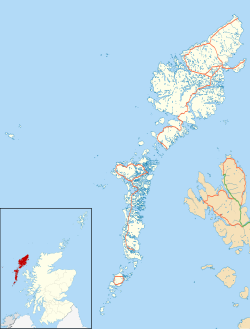| Cnoc Ceann a' Gharaidh | |
 Callanish II seen from the west Callanish II seen from the west | |
 | |
| Location | Lewis |
|---|---|
| Coordinates | 58°11′40″N 6°43′44″W / 58.19444°N 6.72888°W / 58.19444; -6.72888 |
| Type | Stone circle |
| History | |
| Periods | Neolithic, Bronze Age |
The Callanish II stone circle (Scottish Gaelic: Cnoc Ceann a' Gharaidh) is one of many megalithic structures around the better-known (and larger) Calanais I on the west coast of the Isle of Lewis, in the Outer Hebrides, Scotland.
Description
Callanish II is situated on a ridge just 90 metres from the waters of Loch Roag. It is just a few hundred metres from the Callanish III stone circle. See also Callanish IV, Callanish VIII and Callanish X for other minor sites.
The stone circle consists of seven thin standing stones arranged in the shape of an ellipse measuring 21.6 by 18.9 metres. Five of the stones are standing and two have fallen. The stones vary from 2 to 3.3 metres in height. A slab, 1.4 metres long, lies in front of the western stone, pointing towards the centre of the circle. The stone circle surrounds a cairn with a diameter of 8.5 metres.
When 3 feet (1 metre) of peat was removed from the site in 1848, four holes were noticed, three grouped in an arc at the northwest, a fourth at the south-west. Wood charcoal found in them suggests that they formed an earlier timber circle about 10 metres in diameter.
References
- ^ "Site Record for Lewis, Callanish, 'Tursachan' Callanish Ii; Cnoc Ceann A' Gharraidh; Cnoc Ceann; Ceann A'Gharaodh; Calanais". RCAHMS. Retrieved 25 September 2014.
- ^ Burl, Aubrey (2005). A Guide to the Stone Circles of Britain, Ireland and Brittany. Yale University Press. p. 151. ISBN 0300114060.
External links
58°11′40″N 6°43′44″W / 58.19444°N 6.72889°W / 58.19444; -6.72889
| Prehistoric Western Isles | |
|---|---|
| Callanish Sites | |
| Other Neolithic Sites | |
| Bronze and Iron Age Sites | |
This article about a location in the Western Isles is a stub. You can help Misplaced Pages by expanding it. |
This article relating to archaeology in the United Kingdom is a stub. You can help Misplaced Pages by expanding it. |
This article about a Scottish building or structure is a stub. You can help Misplaced Pages by expanding it. |